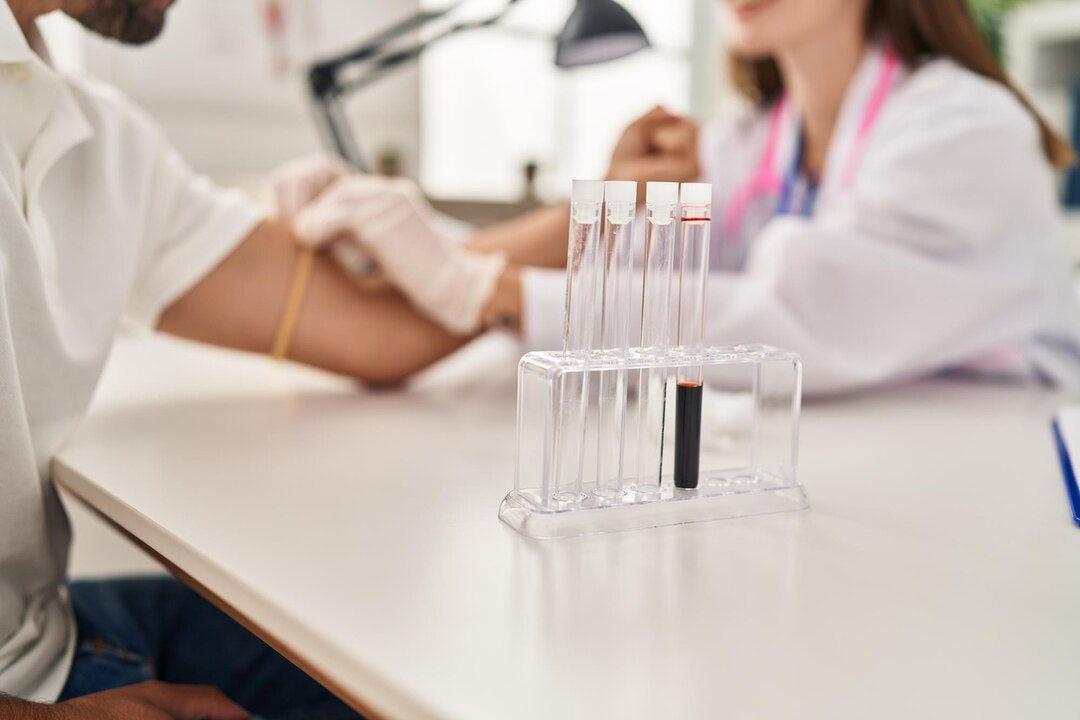
Understanding the AMH Test: Purpose, Procedure, and Results Explained
Time to read 11 min
Time to read 11 min
Table of contents
One of the most useful diagnostic tests when ascertaining a woman's fertility or her ovarian health is the anti mullerian hormone test.
The substance whose blood levels are measured to indicate information about your ovarian reserve is known as AMH or anti müllerian hormone.
This article will attempt to explain what the AMH test is, what it is for, its procedure, interpretation of results, and its role in fertility management and reproductive health.
AMH or anti mullerian hormone is a hormone produced by the small follicles in the ovaries.
These follicles contain immature eggs and are indicative of a woman's ovarian reserve, which refers to the number of eggs remaining in the ovaries.
The AMH test helps determine the level of AMH in your blood, offering a clear picture of the ovarian reserve.
In simpler words, the amh test is a blood test that measures amh levels to calculate fertility potential.
Amh hormone is found in both males and females, but its importance lies in determining ovarian health in women.
The amh test is very important due to the following reasons:
The estimation of the remaining eggs in the ovaries is done with the AMH levels that are imperative in estimating potential fertility.
The results from the AMH test are utilized in procedures like IVF.
Diminished ovarian reserve is diagnosed with lower levels of amh, whereas high amh levels lead to conditions like PCOS.
The test is also useful in tracking ovarian function over time, especially for women undergoing treatments that might impact fertility.
Women may require an AMH test for various reasons, such as:
• Difficulty conceiving or infertility.
• Monitoring ovarian health in women undergoing chemotherapy or other medical treatments.
• Diagnosis or management of conditions like polycystic ovary syndrome.
• Planning fertility preservation, such as egg freezing.
• Response to fertility treatments, in this case in vitro fertilization.
Although fewer people administer it to men, male candidates can also undergo an amh test.
Male AMH is a hormone that also assists the reproductive organs in forming at their developing stage.
The amh test is simple. It only calls for a simple blood extraction;
A healthcare professional draws your blood from a vein found on your arm.
Compared to other tests, an amh test does not necessitate fasting or specific timing.
The test can be performed at any time during the menstrual cycle as the levels of AMH remain relatively stable throughout the month.
Results from the AMH test are expressed as ng/ml. The general guideline for normal amh level and other scenarios include:
The normal range for AMH is 1.0 to 4.0 ng/ml, meaning that it indicates an excellent ovarian reserve.
Values below 1.0 ng/ml might signify that there is reduced ovarian reserve. This means a limited number of eggs and limited potential to have offspring.
High levels of amh can be seen when a value exceeds 4.0 ng/ml, such as conditions with polycystic ovary syndrome, too many follicles in the ovaries, or generally just having a surplus.
It is also worth noting that amh levels alone cannot predict how many eggs will lead to successful conception but provide a woman with insight into her fertility status.
There are several factors that determine the amount of AMH in a woman's blood, such as:
• Age: AMH levels decrease with age, especially after 35 years, due to the decline in ovarian reserve.
• PCOS : Women suffering from PCOS have higher AMH levels due to excess small follicles in their ovaries.
• Ovarian Surgery or Medical Treatments : Treatments to the ovaries or chemotherapy lowers amh levels.
• Lifestyle Factors: Smoking, stress, poor nutrition are bad for ovarian reserve and lowers your AMH level.
The most significant reason for undergoing an amh test to measure amh levels and evaluate ovarian health is for fertility evaluation.
Low AMH may indicate a lower ovarian reserve but does not necessarily mean an impossibility of pregnancy. Women with low amh levels can still conceive naturally, or with fertility treatments.
The primary role of the amh results is to predict how she will react to ovarian stimulation in the IVF process. Those women with normal levels of amh generally respond well to stimulation.
A low level of amh at age 20 or 30 will most likely require fertility preservation as the likelihood of a residual ovarian reserve diminishes over time.
This condition is one of the frequent endocrine disorders in women at the age of child bearing.
Women with PCOS always have high levels of amh in the blood in regard to the increased numbers in the ovaries.
As this would mean an excellent ovarian reserve, it could be of poor quality so presenting difficulties in getting pregnant.
Though the anti müllerian hormone amh test has so much to give regarding insights in ovarian reserve, there is something specific that stands as limitation:
• It cannot explain the quality of eggs.
• It can not predict a chance of spontaneous conception.
• It may not rightly depict the ovarian reserve of the patient with hormonal disorders such as PCOS.
Actually, a doctor may advise someone to take an amh test if they experience challenges conceiving, preparing for fertility treatments or just want to know how their ovarian reserve is.
Especially in women who need to delay pregnancy and want to assess her future potential for fertility.
A normal AMH level is usually between 1.0 and 4.0 ng/ml. This range usually indicates healthy ovarian reserve andreasonable potential for fertility.
Low AMH levels are related to a reduced ovarian reserve, where fewer eggs are expected. This does not relate directly to infertility but may need prompt attention if you wish to conceive in future.
It is a blood test wherein a sample is drawn from your arm through a vein.
Women who cannot get pregnant, are going for IVF, or those who have PCOS will need this test.
This is where the amh test comes in: it's a potent tool for proactive fertility planning.
Whether through assessing ovarian reserve or just evaluating the response to fertility treatment, hormone amh test brings critical information to the forefront.
Those who are diagnosed as having low amh or polycystic ovary syndrome also need personalized plans for their fertility.
Amh levels and what they indicate give women and their healthcare providers the opportunity to make informed decisions about family planning, fertility treatments, and even more general reproductive health.
Advances in reproductive medicine help individuals better understand the intricacies of fertility and take control over their reproductive future through tools such as the amh test.
Anti mullerian hormone test, or AMH, is an essential tool for ascertaining fertility potential as well as ovarian health.
Its role in determining the potential levels of the hormone in your blood may, therefore, be crucial to learning about a woman's ovarian reserve.
This insight is priceless for those wishing to know their reproductive health, planning fertility treatments, or exploring choices for family planning.
And as we consider its importance, its accuracy, and its limitations, the test emerges as the cornerstone of modern reproductive medicine.
At its core, the amh test is a simple, reliable measure of anti müllerian hormone (AMH), which is secreted by the small follicles of the ovaries.
These contain immature eggs, and the number of these follicles correlates directly with the level of AMH in a woman'sbloodstream. This makes it a valuable indicator of ovarian reserve.
For women trying to conceive, it becomes critical to understand their levels of AMH. Knowing what constitutes an AMH level within a normal range—ranging between 1.0 and 4.0 ng/ml—is essential to help make comparisons for assessing fertility.
The normal woman usually has a good ovarian reserve. Those with lower levels need to explore fertility-preserving strategies and perhaps medical intervention, in the form of in vitro fertilization (IVF).
The AMH test primarily assesses ovarian reserve. The number of eggs decreases as a woman ages. In the same manner, the rate of anti müllerian hormone diminishes.
The test measures how much of the hormone there is to give an instantaneous snapshot of the number of eggs available.
The test cannot predict egg quality, which is an important factor in fertility, but it can determine whether the ovarian reserve is sufficient for conception or if time-sensitive measures are needed.
Low levels of AMH can indicate diminished ovarian reserve, which may reduce the chances of conceiving naturally.
On the other hand, high amh levels in some women, especially those with polycystic ovary syndrome (PCOS), may suggest an overabundance of follicles.
While this indicates a high ovarian reserve, it may come with challenges related to egg maturation and ovulation.
Fertility is a complex problem that depends on age, lifestyle, and other pre-existing health conditions.
The anti mullerian hormone amh test is an essential tool in tackling fertility problems. For infertile women, this test offers necessary information that will help make medical choices.
For example, women with low amh may conceive with appropriate fertility treatment, like ovulation induction or IVF.
The test also determines the treatment protocols for women who will be undergoing IVF.
AMH levels predict ovarian response to stimulations of fertility drugs that is very important in optimization of egg retrieval outcomes.
A low ovarian reserve will probably require higher doses of fertility drugs while high amh levels might suggest the risk of OHSS or ovarian hyperstimulation syndrome.
The utility of the amh test goes way beyond fertility planning. The test helps diagnose and manage such conditions as polycystic ovary syndrome, which is basically a hormonal disorder that negatively affects the development of eggs, ovulation, and production of hormones.
Women with PCOS exhibit high amh levels because many small, immature follicles abound in the ovaries.
Moreover, the AMH test can also be useful in monitoring ovarian health among women who are receiving medical treatment that may affect their ability to conceive, such as chemotherapy.
It serves as a baseline for determining how treatments will impact a woman's ovarian reserve, and healthcare providers can then prescribe appropriate fertility preservation methods, like egg or embryo freezing.
While the anti müllerian hormone amh test is a very effective tool, it has limitations to it. Remember that levels of amh alone can't paint the complete picture regarding fertility.
It does not take into consideration the quality of eggs, which is very important for calculating the chances of successful conception.
Low amh levels also do not mean that a woman is infertile. Women with diminished ovarian reserve can still conceive either naturally or with medical help, depending on other factors such as egg quality and overall reproductive health.
Conversely, high amh levels do not necessarily mean that a woman will be fertile, especially if she has conditions such as PCOS.
Another limitation is in the interpretation of results. Although the test gives a general idea of the level of AMH, differences in laboratory techniques and individual hormonal fluctuations can lead to inaccuracy.
For this reason, the test is best used in conjunction with other diagnostic tools, such as ultrasound scans to assess the ovaries and hormone panels to evaluate overall reproductive function.
One of the most excellent advantages of the amh test is that it empowers women with knowing information about their reproductive health status.
It enables them to understand what is happening to their ovaries, then make decisions regarding their fertile and family planning status.
It provides the young woman with the opportunity to evaluate her ovarian reserve early and consider egg freezing if low amh levels are detected.
In the case of the older woman, it helps give a better understanding of whether immediate action needs to be taken to achieve pregnancy.
It also comes in handy with the women suffering from conditions like PCOS since it will monitor the fluctuations in hormonal changes and, accordingly, adjust the treatment regimen.
Additionally, it aids the couples facing infertility by planning with confidence, while using data to direct the course of the treatment.
Although less frequent, men's fertility can be assessed using amh tests. In males, amh is a hormonal chemical that plays a vital role in the development of reproductive organs in males.
Male amh testing can be one way of diagnosing conditions associated with undescended testes and ambiguous genitalia.
With primary importance in female reproductive issues, the test emphasizes the functions of the hormone in more widespread human body functions.
As reproductive medicine continues to advance, tools such as the anti müllerian hormone test are becoming more sophisticated.
Advances in technology may improve the accuracy of amh test results and offer new insights into egg quality and ovarian health.
Future research may also lead to additional applications of the amh test, including being a good predictor of menopause onset and long-term health of ovaries.
As our knowledge on the anti mullerian hormone and its function deepens, so will the list of the test's potential applications.
* Medical Disclaimer - The following information is for educational purposes only. No information provided on this website, including text, graphic, and images, are intended as substitutes for professional medical advice. Please consult with your doctor about specific medical advice pertaining to your condition(s).

